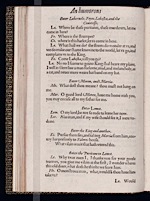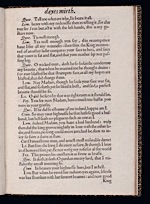- Edition: An Humorous Day's Mirth
Textual Introduction
- Introduction
- Texts of this edition
- Facsimiles
32Setting of the Quarto
In order to determine whether the play was set by forme or in seriatim, the printed quarto was studied for signs of space saving and wasting. These signs can indicate that the compositor had been adjusting the text to fill the pages designated by the casting off procedure, which primarily informs the printer how much paper is required, and is also useful in allowing formes to be set non-consecutively.
33The average page of text consists of thirty-six lines of type, including the text and stage directions embedded within it, but excluding those in the margin. Three exceptions were the first page of text (A2), which features the play title and an ornament, and two pages in which text had been placed in the same line as the catchword (G2v and G3v). Of the remaining pages, one had four white lines (F1v), while two pages had three white lines (B4 and C3). These three pages and their respective formes have been analysed in order to determine whether the use of white lines seemed to correlate with wasting space allocated to that forme. Indications of space saving, which may have impacted on the decision to insert white lines, have also been noted.
34F1v (inner forme) has four white lines, each placed before stage directions. If these are thought to waste space, the stage direction at the top of the page confirms this: ‘Countesseʼ could fit onto the first line of the stage direction, but the compositor chooses to fill two lines. A similar example can be noted on F3v where a three-line stage direction might have squeezed into two lines. Here there are no white lines before or after the stage direction. However, on F4 certain lines of text have been tailored to fit onto one line. Lines 18 and 29 both have considerably, though not unusually, abbreviated speech prefixes: ‘Laberveleʼ becomes ‘La.ʼ while ‘Lemotʼ is signified ‘Le.ʼ for the only time on F4; elsewhere on the page he is signified as ‘Lem.ʼ The text of l. 18 only just fits the line, while the text of lines 28 and 30 have no final punctuation. A mark at the end of l. 28 looks like an accidentally inked quad.
35It is more likely for a compositor to set the text as economically as possible before discovering the need to waste space by expanding the text and inserting white lines at the end of the forme. Since the compositor could set pages of the cast off formes in any order there was no need for him to observe the numerical sequence. This may suggest that F1v was the last page of sheet F (inner forme) to be set, since it is the page on which space wasting is to be found.
36Sheet B (inner forme) also suggests that space was used carefully on certain pages, but wasted elsewhere in the forme. On B1v, effort is made to save space: the last line of Florilaʼs first speech (l. 10) occupies an entire line without final punctuation. The use of an ampersand and the shorter spelling ‘therforeʼ is also of note. At l. 27 ‘Laberveleʼ is shortened to ‘La.ʼ to accommodate a line which also spells ‘womenʼ with a tilde: ‘wom{~e}ʼ.
37Sheet B (inner forme) also suggests that space was used carefully on certain pages, but wasted elsewhere in the forme. On B1v, effort is made to save space: the last line of Florilaʼs first speech (l. 10) occupies an entire line without final punctuation. The use of an ampersand and the shorter spelling ‘therforeʼ is also of note. At l. 27 ‘Laberveleʼ is shortened to ‘La.ʼ to accommodate a line which also spells ‘womenʼ with a tilde: ‘wom{~e}ʼ.
38In comparison, B3v and B4 are very different in their composition, particularly the latter. Florilaʼs words on B3v at ll. 11-12 could occupy one line, but the compositor has inserted extra spaces. Similarly, the final two lines of Lemotʼs long speech illustrate not an excessive utilisation of space, but the lack of need to economise: ll. 28-29 could have squeezed into one if the spelling ‘farreʼ had been shortened and a tilde been used in ‘reputation.ʼ Space is used liberally on l. 36 with additional spaces inserted between words so that ‘sayʼ appears at the top of B4, a word which could have been accommodated on B3v. B4 itself has three white lines, one before and two surrounding stage directions.
39Sheet C (outer) bears fewer marks of spatial problems. The main point of note occurs on C3 where two stage directions are flanked by two and one white line respectively. However, these may signify a wish on the part of the compositor to break up the long speeches of text which appear as solid blocks to the eye.
40A survey of stage directions revealed that while eighteen stage directions had white lines before, four had them before and after, and twenty-seven stage directions had no white lines at all, although four of these could be explained due to their placement at the top or bottom of a page. It is difficult to conclude whether the compositor preferred to set white lines before stage directions and therefore used none when space was scarce, or whether he only inserted white lines to waste space, and preferred setting stage directions without. It is also possible that the compositor preferred to set white lines before stage directions at the beginning of a new scene, where there might be a corresponding break in the manuscript.
41A brief study of individual inner and outer formes reveals patterns of space-saving and space-wasting, indicated by lack of punctuation, alteration of spelling, insertion of white lines and larger spaces between words and punctuation, which suggests adjustments being made to fit text into the pages unset between already composed formes. Of course, casting off also helps estimation of the length of the text and thus the amount of paper required for printing. It is also more likely that setting by formes was employed, as opposed to ‘seriatimʼ, when two compositors were working on one text. However, as Philip Gaskell observes ‘setting by formes appears to have been a common practice in English and in some continental printing up to the mid seventeenth century.ʼ[173] Gaskell also suggests setting by formes helped printers make use of a limited stock of type.


